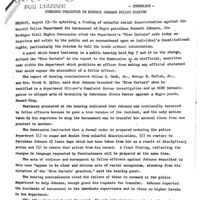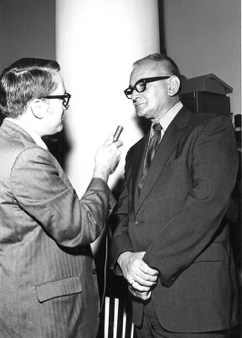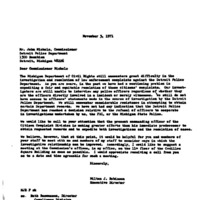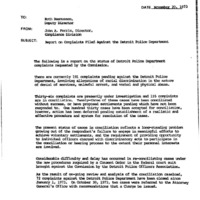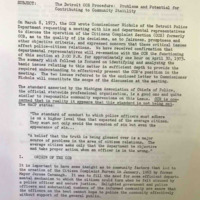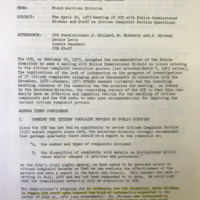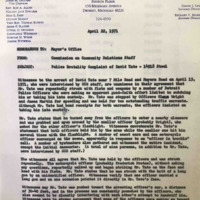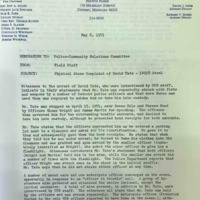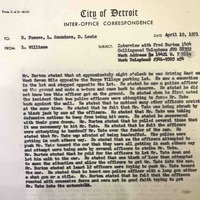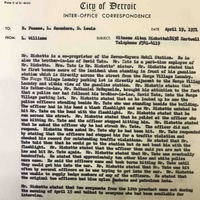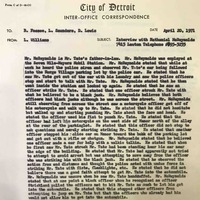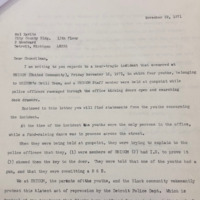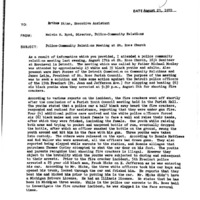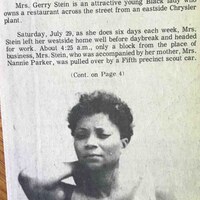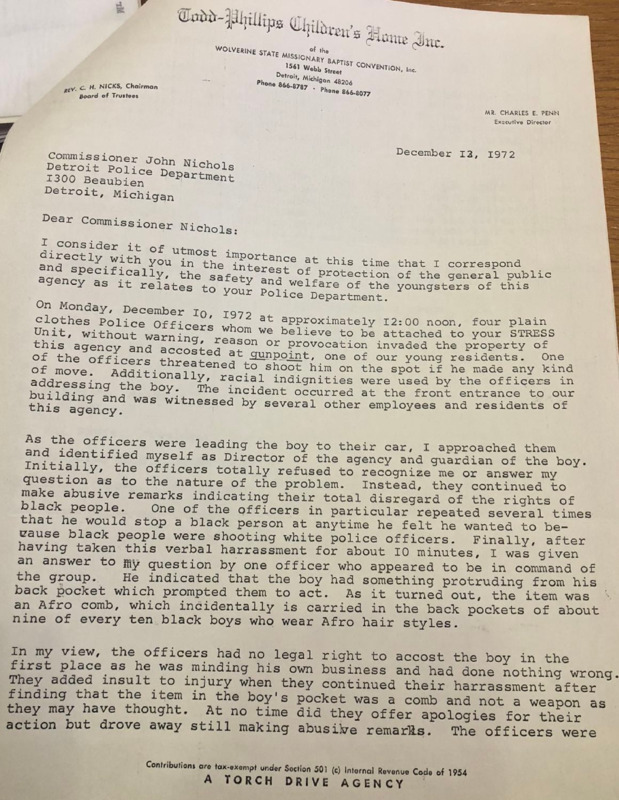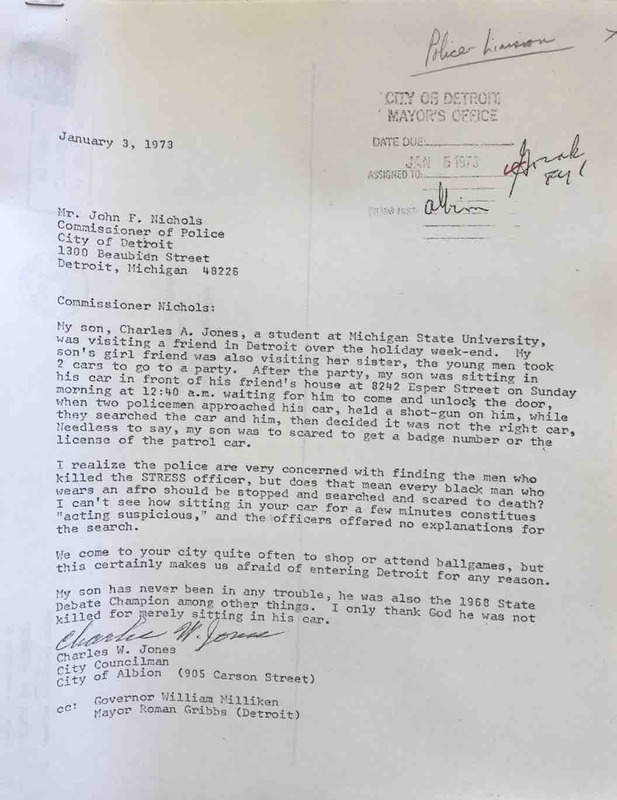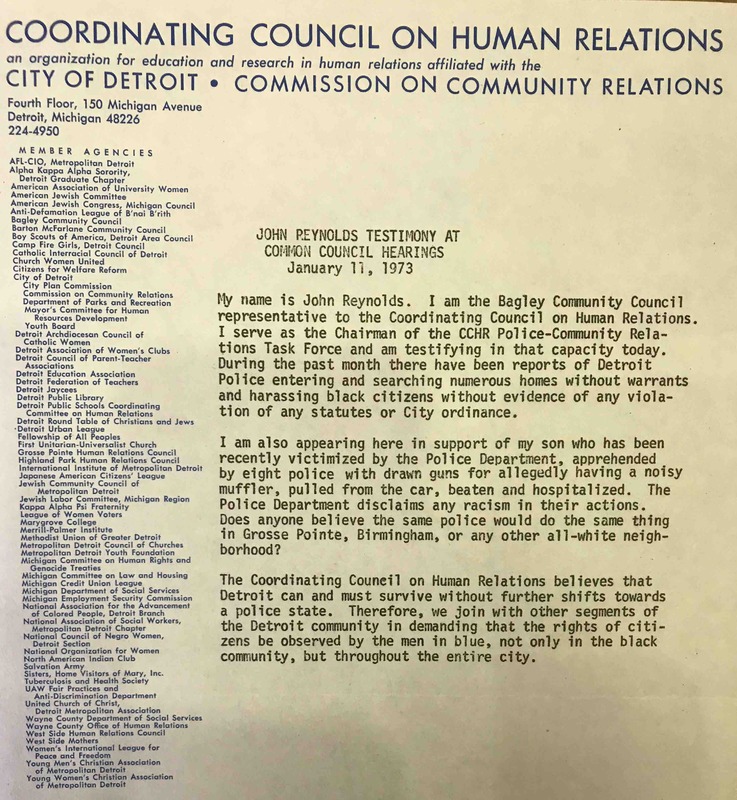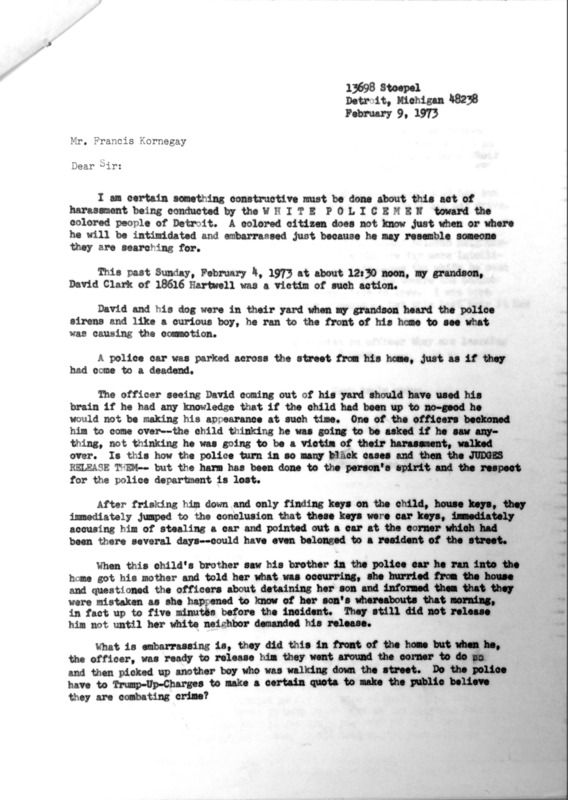Patterns of Police Brutality 1971-73
"The Blue Curtain"
The Detroit Police Department's "Blue Curtain" covered up almost all cases of brutality and misconduct against civilians, including felony-level criminal assault and even murder, and the DPD as an institution whitewashed internal investigations and consistently stonewalled external inquiries. The "Blue Curtain" was a phrase widely used among police officers themselves and described, in the findings of a 1968 investigation by the Michigan Civil Rights Commission (right), the "unofficial, unwritten code within the department which prohibits an officer from making any official statement that would expose the misconduct of a fellow officer." The very few police officers who decided to buck the "Blue Curtain" faced direct and often-career-ending retaliation, and civilians who filed official complaints against police officers, or even just verbally protested harassment and misconduct during traffic and pedestrian stops, often suffered physical violence, intimidation, and wrongful arrest in response. It may well be true that a relative minority of police officers committed a disproportionate share of excessive force and criminal misconduct incidents involving civilians, but it is also undeniable that an overwhelming majority of DPD officers and the entire department hierarchy participated in the code of silence and lies that covered them up through what was a corrupt, organized, and at times criminal conspiracy.
The obstacles to both internal and external investigations of officer brutality and misconduct increased during the late 1960s and early 1970s because of several key developments. After the 1967 Uprising, the Michigan Civil Rights Commission conducted an extensive investigation of police brutality against Black citizens in Detroit, but the DPD refused to act on its findings and the Detroit Police Officers Association union filed a lawsuit contesting the state agency's authority. The consent decree settlement in 1970 affirmed the MCRC's right to investigate but also stipulated that because of the collective bargaining agreement, only the DPD Commissioner and internal Trial Board had the authority to impose discipline. In these rare cases, the DPOA union almost always appealed to the courts or arbitrators, often with success. The DPD under Commissioner John Nichols also deliberately understaffed and undermined its Citizens Complaint Bureau, which at any rate found most allegations unjustified and almost always took the word of police officers over civilians. The Michigan Civil Rights Commission concluded that most citizens, especially Black residents of Detroit, did not even bother to file complaints because of "lack of confidence" in the process, which was a bureaucratic understatement.
Stonewalling External Investigations. In November 1971, the Michigan Civil Rights Commission sent Police Commissioner John Nichols the latest in a four-year series of letters and reports that the DPD was continuing to obstruct a "fair and equitable resolution" of investigations into citizen complaints and that the "refusal of officers to cooperate" was uniform (gallery below, left). Nothing of substance happened in response. Two years later, in November 1973, the MCRC reported 191 active complaints of racial discrimination pending against the DPD, most for wrongful arrest or physical and verbal abuse, with resolution of most impossible because of the department's blanket refusal to cooperate (gallery below, second from left).
The Detroit Commission on Community Relations (DCCR), the city government's civil rights agency, battled DPD obstruction throughout the tenure of Commissioner John Nichols, as detailed earlier in this section. In 1973, the DCCR compiled a report (gallery below, second from right) documenting its long and unsuccessful struggle to convince the DPD to make its Citizens Complaint Bureau either impartial or responsive to citizen allegations of police brutality and misconduct. The resistance dated to the formation of the Citizens Complaint Bureau in 1965 but had intensified since 1970 under the administration of Mayor Gribbs and Commissioner Nichols (who infamously denied that any DPD officer had broken any laws or department regulations during the brutal manhunt of December 1972/January 1973). The DPD had also started refusing to share any internal records with the DCCR, making it impossible for the municipal agency to conduct thorough investigations as it had attempted to do before Nichols's promotion in 1970. The Citizens Complaint Bureau had a massive backlog, and completed investigations almost always "resulted in a 'not sustained' finding in the face of the bulk of available evidence supporting an opposite conclusion." The DCCR specifically recommended that the police department:
- Appoint an independent special prosecutor for internal Trial Board hearings
- Appoint civilians to the Citizens Complaint Bureau and to the internal Trial Board
- Consult with the DCCR on investigations and disciplinary decisions involving police officers
Commissioner John Nichols did not make any substantive changes in response to the criticism from the Michigan Civil Rights Commission and the Detroit Commission on Community Relations. In response, the DCCR moved beyond calling for civilian consultation in the DPD's internal investigations and endorsed a civilian review board, because "it is inconceivable that the Police Department can investigate itself." Civil rights groups and Black community activists also continued to call for a civilian review board, as they had consistently since the late 1950s, but Mayor Roman Gribbs and Police Commissioner John Nichols adamantly refused even to consider such a possibility. This guaranteed that almost no officer would be disciplined for acts of brutality and misconduct against civilians during this time period, and that documentation of most such incidents is not even available in the historical record, which is the subject of the next section on this page.
Mapping Police Brutality and Misconduct Incidents (1971-1973)
It is impossible to fully document the degree and nature of police brutality and misconduct during encounters with citizens and civilians in the city of Detroit. The official complaints filed with the DPD's Citizen Complaint Bureau represent only the tip of the iceberg and are buried in closed and disorganized archives. Protections negotiated or litigated by the police union make key information exempt from Freedom of Information Act requests, which are expensive and require specific knowledge that is often unavailable in the public record. The archives of the Detroit Commission on Community Relations, at Wayne State University's Reuther Library, contain far fewer incidents between 1971-1973 than for previous time periods covered in this exhibit because the DPD stonewalled the agency's requests for information, as described above. Most of the complaints filed with the Michigan Commission on Civil Rights are confidential and privileged in the state archives. The papers of the Detroit chapter of the NAACP are missing for this time period. Civil litigation files are located in the basement of the Wayne County courthouse and very difficult to obtain without prior knowledge of the specifics of the complaint.
The map below provides a sampling of the broader patterns of police brutality and miconduct by documenting 59 specific incidents involving more than 100 civilians, almost all African Americans. The research team located these incidents through newspaper database research, complaint letters sent directly to Mayor Roman Gribbs and other politicians, and information gathered by the Labor Defense Coalition in its civil lawsuit against STRESS (the source for each incident is in the pop-up box). Many of these incidents are from the DPD manhunt for three fugitives in the shooting of STRESS officers, although the majority of manhunt complaints made by Black citizens during a city council hearing and to the people's tribunal held by the Independent Black Commission of Inquiry into Police Terror are not included because specific location information is not available. Police homicides are mapped on a separate page, as are the fatal and non-fatal STRESS shootings that often included beatings of police victims. Two major categories of criminal and illegal police misconduct that do not involve direct abuse of civilians are also documented on other pages: police corruption in narcotics trafficking, and the DPD's unconstitutional surveillance of political activists.
This interactive map locates the identified police brutality and misconduct incidents in Detroit's racial geography. The darkest blue areas are all-Black neighborhoods, and the darkest green are segregated white areas, with the shifting racial boundary in between. Click on the dots to learn more about each incident, and scroll down for case studies of key encounters. The category of police brutality involves direct physical violence by law enforcement officer(s), and police misconduct refers to racist verbal abuse, wrongful search and/or arrest, and similar allegations. The most common trigger for police violence was the assertion of constitutional rights by Black citizens to white police officers, especially any response other than complete and total submission during warrantless home invasions, traffic stops, and "stop-and-frisk" racial profiling operations.
Map of Police Brutality and Misconduct Incidents, 1971-1973, in Detroit's Racial Geography
- Black dots (36) = Police Brutality
- Red dots (17) = Police Misconduct
- Yellow dots (6) = Sexual Assault and Misconduct
-
Half of the incidents on the above map are from the DPD manhunt between Dec. 1972 and Feb. 1973.
-
Ten brutality incidents involved STRESS units, mainly the beating of African American males who were shot non-fatally or were witnesses to fatal shootings.
-
Six of the incidents involved rape or sexual assault of Black females by police officers. In two of the three identified rape cases, the officers were charged. Other sexual assault incidents occurred at gunpoint inside private homes during the manhunt, with one involving multiple college student victims.
-
All but one of these incidents involved African Americans. In the one that did not, DPD officers beat multiple white youth during a protest of the fatal shooting of a 20-year-old white male who was killed while riding in a car and not involved in any criminal activity.
-
These 59 incidents only represent a small fraction of brutality and misconduct encounters with police officers during this time period.
Ten Case Studies of Police Brutality and Violence (1971-1973)
This section profiles 10 non-fatal incidents of police brutality and misconduct included in the above map. Related incidents of brutality and misconduct are detailed elsewhere in Section V, including patterns of officer sexual assault against Black women, the coverup of the "Fifth Precinct Incident" in July 1972, the mass constitutional abuses of the STRESS manhunt in late 1972/early 1973, the charges of Black citizens to the indendent people's tribunal in Feb. 1973, the organized police criminality in the Pingree Street Conspiracy exposed in April 1973, and the DPD's systematic and unconstitutional surveillance of political activists.
David Tate (April 15, 1971). Tate, an African American adult male (age unknown, probably early 30s), was driving in northwest Detroit and pulled over for speeding by Patrolmen Glenn Wright and James Martin. They attempted to arrest Tate for outstanding traffic warrants, even though he had receipts proving that he had paid the tickets. When Tate verbally protested the arrest and turned away to take his clothes into a laundry, one officer grabbed him and the other began beating him with a flashlight. Multiple scout cars with around 15 officers arrived on the scene and immediately joined in the physical assault on David Tate, taking turns while others held his arms, and at least one pointed a rifle in his face and another beat him with a blackjack. At least eight civilian witnesses confirmed this version of events and insisted that Tate was not resisting arrest. The DPD claimed that Tate had punched an officer in the chest and was therefore responsible for everything that ensued. David Tate denied this claim. A judge almost immediately released Tate and labeled the arrest to be unjustified. Tate was then hospitalized. The Detroit Commission on Community Relations investigated after Tate filed a complaint and secured the eyewitness testimony included in the gallery below and five other similar accounts. The DCCR report summarized the findings: "Mr. Tate was repeatedly struck with fists and weapons by a number of Detroit police officers and more force was used than was required to subdue him or take him into custody." The police union refused to allow the DCCR to interview the officers involved, and the DPD closed the 'internal investigation' on their word. A court dismissed the charges against Tate based on the right of a citizen to resist an illegal arrest.
UNICOM Incident (Nov. 12, 1971). Around twenty plainclothes and uniformed DPD officers launched an evening raid on the offices of UNICOM, a Black community organization, carrying semi-automatic weapons, sawed-off shotguns, and long rifles. UNICOM (United Community Organizations) was a youth-oriented activities center on the city's West Side that was holding a fundraising dance across the street that night. The police officers later claimed that they were responding to a report of a Black youth with a gun and a burglary in progress, but UNICOM members portrayed the episode as part of a longer tradition of white DPD officers criminalizing, intimidating, and brutalizing Black community-based organizations.
When a white police officer in plainclothes kicked open the UNICOM office door brandishing a semi-automatic weapon, there were four youth from a drill team, between ages 11 and 15, present in the building, changing clothes in order to join the dance. The first officer threw the nearest Black youth against the wall, and DPD officers burst in multiple entrances, with others on the roof of the building. They held the four UNICOM members present at gunpoint, yelled racist slurs, and did the same to a staff member who arrived during the incident. DPD officers ransacked the building, including file cabinets and desk drawers, and then at some point said that they were at the wrong location. The UNICOM youth director accused the DPD of a racist and "blatant act of repression" and demanded an investigation of the violations of their civil and constitutional rights. Officials in the 12th Precinct said they had no record of a police raid at the address from the log books and did nothing.
Firecracker Incident (August 8, 1972). Around 9:30 in the evening, a group of Black teenagers set off some firecrackers after a Catholic youth group meeting in the St. Rose Parish on the far west side of Detroit. The incident occurred in a racially transitional area not far from the all-white Grosse Pointe suburbs and and in a part of the city where DPD units, including STRESS, had been patrolling to monitor Black youth and police the color line. A police squad car heard the noise and radioed in a report that the officers were facing gunfire. Four squad cars rushed to the scene, and all of the police officers present were white. The police forced seven African American teenagers, six male and one female, up against the wall at gunpoint for a stop-and-frisk search. One of the youth dropped an unopened bottle of rum, and a police officer smashed him in the face with a pistol. The police arrested three of the male youth and let the others go. The arrested youth said that once in custody, en route to the 5th Precinct station, the officers slapped and otherwise abused them. The priest of St. Rose Church called a community meeting attended by the youth and their families, along with friends of both races, and they determined to file a complaint with the DPD and ask the Michigan Civil Rights Commission for an investigation (right). The DPD stonewalled the MCRC, as usual.
Mrs. Gerry Stein (July 29, 1972). Mrs. Stein was driving to the East Side restaurant that she owned at 4:25 a.m. when a 5th Precinct patrol car pulled her over for speeding. Her mother was also in the car. When she insisted that she had not been exceeding the speed limit, the white officer said, "you're one of those smart bitches. I do bitches like you every day." Mrs. Stein made a reference to the effect that the officer would be judged by God for his actions, and the patrolman slammed the car door on her leg and then threw her face down into the middle of Mack Avenue and handcuffed her. When her mother told the officer to stop, he threatened her with his gun. Mrs. Stein sought hospital treatment and then filed a complaint with the DPD and hired a well-known civil rights attorney. She also contacted the Michigan Chronicle and requested that the newspaper publicize her story and a photograph of her injuries (left). The Chronicle editorialized that the DPD was engaged in a "pattern of calculated disregard for the rights of citizens and of the very laws police officers are sworn to uphold" and also noted that the patrolmen in question had shot and killed a Black man just six days after abusing Mrs. Stein.
Linda Sue Watson and John Robertson (Oct. 12, 1972). Linda Watson, a Black woman visiting from the distant industrial suburb of New Haven, was driving her boyfriend home from work and accidentally turned the wrong way down a one-way street. A squad car pulled them over, and the couple charged that a white officer began to taunt and threaten them for no reason. When Linda Watson protested, the patrol team beat her with a flashlight and threw her against the squad car and to the ground. They also beat John Robertson, including after he was handcuffed. The beatings stopped only when a backup car with Black officers arrived, but John Robertson testified that the white officers beat him some more en route to the station and in a precinct holding cell. Another white officer kicked Linda Watson in the precinct station. The DPD charged Watson and Robertson with assault and battery. Multiple witnesses telephoned the Michigan Chronicle and confirmed Watson and Robertson's account of an unprovoked assault by the white officers.
Earnest Junior Ragan (Dec. 30, 1972). Ragan, a 22-year-old Black male, was beaten and permanently disabled by a group of twelve Tactical Mobile Unit officers who raided a West Side bar during the DPD manhunt. The DPD claimed that Ragan "became unruly" as the officers searched and interrogated 50 completely innocent bar patrons at gunpoint. His sister, who was present in the bar, insisted that Ragan was very inebriated and only "mouthed off" to the officers, which the bartended confirmed. The TMU officers took Ragan out the back door and beat and kicked him viciously, probably while he was handcuffed. They took Ragan to the hospital in custody, where he had emergency surgery for a brain clot. The prosecutor charged Ragan with assault and battery of police officers. The city of Detroit ultimately paid Ragan $150,000 to settle a civil lawsuit, in recognition that the TMU officers had assaulted and wrongfully arrested him.
"Manhunt" Racial Profiling Incidents (Dec. 1972-Feb. 1973). The brutal DPD manhunt for three Black male suspects in the shooting of multiple STRESS officers, one fatally, generated massive community protests and even a people's tribunal between December 1972 and February 1973. The mass abuses of civil and constitutional rights during the manhunt, including armed and warrentless home invasions and systematic racial profiling of Black males in the search for the suspects, is documented extensively in the final part of this section. This gallery contains four additional accounts of the racial profiling and abuse of completely innocent Black male youth during these events. The DPD denied that any of its officers broke laws or department regulations during the manhunt crackdown.
- Male Resident of Todd-Phillips Children's Home (Dec. 10, 1972). Four plainclothes STRESS officers invaded a Baptist children's home for Black youth around noon, held and threatened a resident at gunpoint, used racist slurs, and placed him under arrest. The director of the children's home (and legal guardian), who filed the complaint directly to Police Commissioner Nichols, intervened and demanded the youth's release, which led to additional racist abuse and threats of violence. The Citizens Complaint Bureau did investigate and exonerated the officers of any wrongdoing, without even interviewing them. Four African American officials from the Baptist hierarchy in Michigan then condemned the DPD for its biased and whitewashed investigation.
- Charles Jones (Dec. 31, 1972). Jones was a Michigan State University student from Albion visiting friends for the New Year's festivities and sitting with them in a parked car when two police officers held a shotgun to his head and then left without explanation. His father complained to the police commissioner, asking if "every black man who wears an afro should be stopped and searched and scared to death?"
- John Reynolds (Jan. 11, 1973) testified at the city council's hearing on the manhunt abuses that eight DPD officers had pulled his son out of a car at gunpoint and beaten him, requiring hospitalization. Mr. Reynolds asked: "Does anyone believe the same police would do the same thing in Grosse Pointe, Birmingham, or any other all-white neighborhood?"
- David Clark (Feb. 4, 1973), a young teenager, was playing with his dog in the front yard when a police car drove down his street and the officers jumped out and frisked him, found his house keys in his pocket, and accused him of stealing a car. They put David in the patrol car, and four more squad cars arrived as backup. The police ignored his mother's protests and released David only after a white neighbor vouched that he was not a criminal or a car thief. David's grandmother, Mrs. Meneco Hitt, filed a complaint with the Detroit Urban League and accused white policemen of "Trumping-Up-Charges on innocent citizens" in order to meet a quota and convince the public that they were winning the war on crime.
Coda: "To Serve and Protect"
Isaiah (Ike) McKinnon, an African American officer who joined the DPD in 1965, ran up against the "Blue Curtain" of police silence and coverups of brutality by fellow officers many times during his career. In 1972, McKinnon was a sergeant in the 10th Precinct when he intervened to stop a group of white police officers from beating and kicking three Black teenagers after a chase. In an interview, McKinnon explained the internal police culture that civilians who resisted arrest, especially by fleeing, or otherwise did not provide complete submission to police officers were deserving of violent retaliation. Afterward stopping the white officers, he went back to the precinct station house and had the following exchange with the lieutenant on duty:
- McKinnon: "A number of officers were savagely beating three young men on the street and I stopped it."
- Lieutenant: "What are you going to put in your report?"
- McKinnon: "Exactly what I saw."
- Lieutenant: "Ike, if you do that you're going to cause these guys to lose their jobs."
In the video excerpt below (4:28), Ike McKinnon describes this incident and the repeated efforts by the DPD hierarchy to convince him to drop the matter, revealing the "Blue Curtain." He also recites the law enforcement code of ethics that police officers are supposed to "respect the constitutional rights of all," which he believed and tried to follow, while many in the DPD did not. And he concludes: "What happens is that officers become a part of this system and they see something and they don’t stop it . . . and that is one of the most unfortunate things that officers do or don't do—you're there to serve and protect."
Sources
Sources for mapped incidents are in the pop-up boxes.
Michigan Civil Rights Commission, Records Relating to Detroit Police Department, RG 74-90, Michigan State Archives
Detroit Police Department Additional Papers (1965-1993), Burton Historical Collection, Detroit Public Library
Detroit Commissions on Community Relations (DCCR)/Human Rights Department, Walter P. Reuther Library, Archives of Labor and Urban Affairs, Wayne State University
Mel Ravitz Papers, Walter P. Reuther Library, Archives of Labor and Urban Affairs, Wayne State University
Roman S. Gribbs Mayoral Records, Burton Historical Collection, Detroit Public Library
Detroit Urban League Records, Bentley Historical Library, University of Michigan
Kenneth V. and Sheila M. Cockrel Collection, Walter P. Reuther Library, Archives of Labor and Urban Affairs, Wayne State University
"Police and the Black Community," 4-part series, Michigan Chronicle, Feb.-March 1973
Unicom incident: Michigan Chronicle, Dec. 4, 11, 1971
Gerry Stein: Michigan Chronicle, Aug. 12, 1972
Watson and Robertson: Michigan Chronicle, Oct. 14, 1972
Earnest Junior Ragan: Detroit Free Press, Jan. 5, 1973, July 28, 1977
Isaiah McKinnon, Stand Tall (2001)
Isaiah (Ike) McKinnon Interview, Part 1, December 3, 2019, https://lsa-dss.mivideo.it.umich.edu/media/t/1_rxtil0md/145739741

